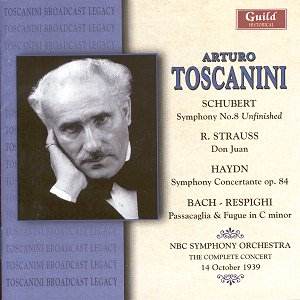Guild is producing some mouth-watering historical issues
– many of them operatic – and this is the first of their Toscanini Broadcast
Legacy. The source material derives from Richard Blaine Gardner, one
of Toscanini’s favourite RCA Victor engineers and editors, who received
discs and tapes direct from the conductor and his son, Walter. It’s
these discs, first generation copies with broadcast commentaries and
introductions intact, to which Guild has had access. Restoration has
been carried out by Richard Caniell at the Immortal Performance Recorded
Music Society in British Columbia. No equalization or compression has
been used which means that acetate ticks and scratches are present.
I don’t think it would have hurt to remove or minimise them, despite
the technical note to the effect that by so doing the instrumental overtones
would have been compromised.[ see footnote] There
are ways and means. In the event the imperfections are minor and not
remotely off-putting, especially considering a recording date of October
1939.
The Schubert is a dramatic, coiled performance characterised
by clarity of articulation and melodic line, each strand weighted and
delineated with optimum projection. Very impressive in its way it confirms
Toscanini’s credentials as a Schubertian of unsentimentalised excellence.
Don Juan, however, for all Toscanini’s string moulding
and passionate rhetoric, emerges strangely diminished. It seems to me
too fragmentary and emphatic a reading, too dramatically leonine. There’s
little of the quality someone such as Clemens Krauss would regularly
mine from the core of the music. Others will doubtless find the blazing
intensity very much to their liking but for me this is a performance
that for all its qualities remorselessly fails to cohere.
The Haydn is yet more recorded evidence of Toscanini’s
genuine affinity with and mastery of the medium. Though he programmed
Haydn often he recorded relatively little and almost everything I have
heard of it has been splendid. This performance, with a superb cast
of principals, violinist Mischa Mischakoff (beautifully sweet of tone),
cellist Frank Miller (in fine form), oboist Robert Bloom and bassoonist
William Polesi, is a most congenial and affectionate affair, well balanced.
As a reading I wouldn’t necessarily prefer it to the Fritz Busch recording
of 1951 but it is a more than welcome addition to the discography. The
Bach-Respighi is Stokowski-plus in impulse, a thrillingly naughty orchestration
that owes its existence to Toscanini having heard Reiner conduct Respighi’s
orchestration of the D minor Toccata and Fugue. The following year,
1930, he commissioned the orchestration recorded here.
Guild’s presentation is comprehensive and there are
thoughtful notes by William Youngren.
Jonathan Woolf
See also review by Chris
Fifield
Footnote
Jonathan Woolf is misinformed.
I believe the ticks and clicks left on the final Master
are indeed small...... and it says in the booklet we have Cedared (De
Clicking and De Crackled using very low thresholds to avoid interfering
with the actualmusic) but not Equalised or Compressed. As you know -
Equalisation and Compression has absolutely nothing to do with Clicks
and Scratches!!!!! We have removed thousands of clicks and scratches
- the Cedar system (11,600 each unit) actually evaluates each side of
the click or scratch and then removes it and finally interpolates the
binary equation in the space (lasting a microsecond or 4!) - it will
do 5,000 of these a second we are told! Likewise huge clicks have been
excised by hand in the computer (Sonic Solutions and Wave lab). So much
has been done on these very early masters - all taken from 16inch metallic
discs revolving at an approximate 33 1/3 when they were originally cut.
Electric current in those days being as amazingly today infinitely variable!!!
Jonathan Wearn -Guild,


